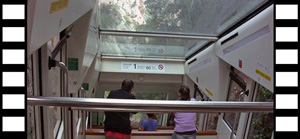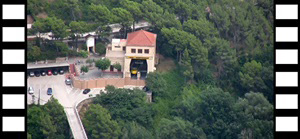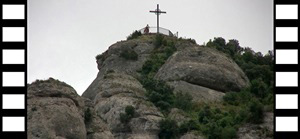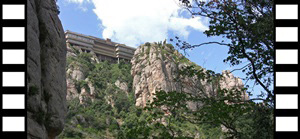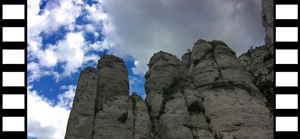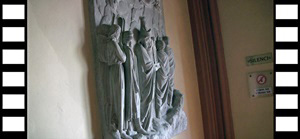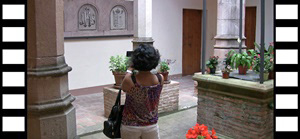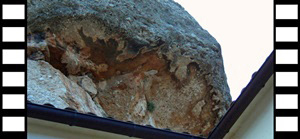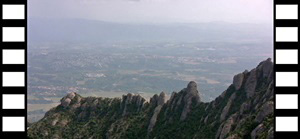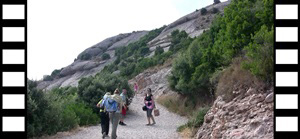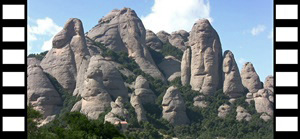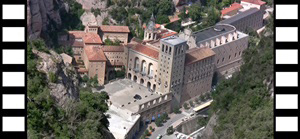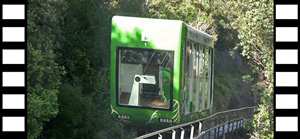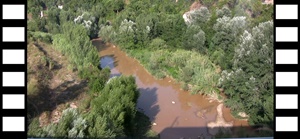On emerging from the monastery, it occurred to us that the package tickets we’d bought included
admission to a museum. We found the museum across from the station at which we’d been dropped
off from the rack railway and went in.
The Museum
We found an assortment of paintings, a few by well-known artists such as El Greco, Dalí, Picasso
and Miró, and some interesting artifacts. Unfortunately, photography was not permitted, so I was
only able to get this picture that I took by accident:
Clock Mechanism
Also included in our package tickets was admission to two funiculars located near the museum. One
of the funiculars goes up (the Sant Joan), and one goes down (the Santa Cova). We
elected to try the Santa Cova funicular first.
Monastery from Funicular Station
We followed the signs and boarded, and were taken down to a trail which leads to the Santa Cova chapel.
Riding the Santa Cova
The chapel is about a mile from the drop-off point, and there are some very nice views to be
had from points along the trail.

Aeri de Montserrat

View from Start of Trail

Valley and Aeri de Montserrat Station

Rocks and St. Michael's Cross

St. Michael's Cross, Rocks and Valley

Rocks and Monastery Building

Rocks

Nella on Trail and Monastery Building

Aeri de Montserrat

Valley from Trail
Also along the trail are 15 sculptural groups dedicated to mysteries of the rosary (for
non-Catholics such as myself, a rosary is a sort of beaded necklace thing with a specific
arrangement of beads that helps one pray in a certain way, or such is my understanding; I’m
not sure what’s mysterious about them - an expert, such as any Catholic, would be able to give
you a better description). Some of these sculptural groups were executed by well-known Catalan
artists (Gaudí worked on one, for instance).

The Presentation of Jesus

Jesus at the Temple

Jesus in the Orchard of Getsemani (1897, Matali and Campeny)

Trail and Rocks

Crucifixion (Cadafalch and Llimona)

Resurrection (1907, Gaudí, Llimona and Renart)

Resurrection (Gaudí, Llimona and Renart)

The Coming of the Holy Ghost

Iron Butterflies

Coronation of the Virgin (1906, Llucià)
After walking the trail we eventually arrived at the Santa Cova chapel, which is a chapel that
was built around the cave in which the Virgin of Montserrat is said to have been found in the
9th Century. There has been a chapel here since around 1700, though the original was heavily
damaged during the Napoleonic Wars and had to be rebuilt in 1859. Damage during and following
a forest fire in 1994 led to its latest restoration, which was completed in 1997.
Santa Cova (Chapel of the Holy Grotto)
The cave of the Virgin is nicely presented, with a copy of the Virgin figure and effective
lighting. There is a bank of candles in the room set aside for viewing of the cave.
Nella and Holy Grotto

Nella, Holy Grotto, Candles and Reliefs

Candles
A second room is used to display a peculiar collection of objects that have been left or
sent in as offerings or expressions of gratitude, or maybe both, I’m not exactly sure. There
are articles of clothing, motorcycle helmets, artificial limbs, photographs and rosaries,
among other things.
Offerings at Chapel
The chapel also has a tiny but well-maintained courtyard or cloister.

Nella and Chapel Courtyard

Courtyard and Overhanging Rock
Following our visit to the chapel, we retraced our steps back to the funicular and rode it
back up to monastery level.
Annunciation at Base of Funicular
At this point we disembarked and boarded the other funicular, the Sant Joan, which took
us up the mountain from the monastery. This trip ended on a ridge from which we could see what
was on the other side of the mountain (more mountain, and a valley beyond). This also seemed
to be a confluence of trails leading to other parts of the mountain. We were tempted to wander
around a little, but it was getting late and we wanted to make sure we had rides back down the
mountain, so we stayed close to the funicular station.

View from Pla de les Taràntules

View from Pla de les Taràntules

Trail and Nella at Funicular Station

Bob
There was a small observation deck on top of the station from which we could see some picturesque
rocks. We also had a birds-eye view of the monastery complex.

Group of Rocks

Nella and Group of Rocks with Sign
Bob and Rocks

Rocks and Monastery from Above

Monastery from Top of Funicular
Eventually we re-boarded the funicular for the trip back down to the monastery.
Waiting for the Funicular
From here we caught the rack railway back down to the valley train station.

Crossing a River

Back in the Valley
The regular train took us from here back to Barcelona, where we found some dinner and returned
to the hotel. We rested up for the next day, not because we had a lot of things planned (though
we had a few things in mind), but because the next day was to be our last in Europe for this
trip, and we knew we would have to do any last-minute shopping and make preparations for our
departure.




